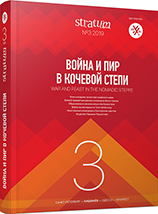Боевые травмы у ранних кочевников «савромато-сарматского» облика как отражение социально-политической обстановки в степной полосе Евразии в VI—II вв. до н. э.
Combat Injuries of the Early Nomads of the “Savromatian-Sarmatian” Appearance as a Reflection of the Social and Political Situation in the Steppes of Eurasia
Author(s): Egor P. Kitov, Alexander A. Khokhlov, Sergey S. IvanovSubject(s): History, Social Sciences, Archaeology, Sociology, Military history, Social history, Ancient World, Victimology
Published by: Издательский дом Stratum, Университет «Высшая антропологическая школа»
Keywords: Volga-Ural region; Ural River basin; Early Iron Age; armed conflicts; trauma; craniology;
Summary/Abstract: The study is devoted to traumatic injuries on the crania of the early nomads of the Volga-Ural region. According to the results of the analysis it can be noted that a small number of injuries together with no stress indicators suggest a safe existence of the population of the early Iron Age in this territory. It is important to say that the injuries are mostly antemortem (with traces of healing) and were probably received in combat. Provided that there are practically no fatal injuries in the burial grounds, this may indicate the absence of conflicts on the territory of the nomadic Savromatian-Sarmatians. However, the abundance of weapons in burials suggests that the society was rather militarized, while the number of individuals with injuries incompatible with life is negligible. Apparently, military conflicts took place outside the territory occupied by the early Savromatian-Sarmatians, which may suggest existence of a major tribal union that influenced the historical processes in Eurasia.
Journal: Stratum plus. Археология и культурная антропология
- Issue Year: 2019
- Issue No: 3
- Page Range: 169-180
- Page Count: 12
- Language: Russian
- Content File-PDF

